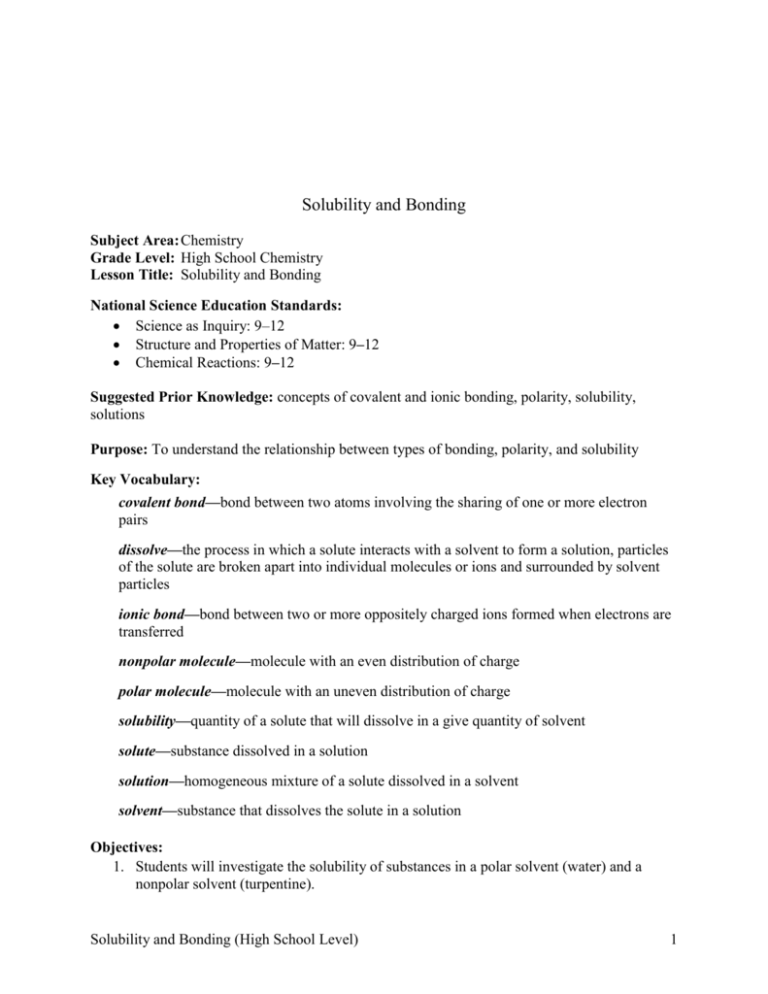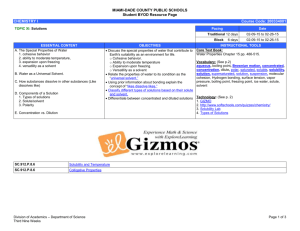Solubility and Bonding
advertisement

Solubility and Bonding Subject Area: Chemistry Grade Level: High School Chemistry Lesson Title: Solubility and Bonding National Science Education Standards: Science as Inquiry: 9–12 Structure and Properties of Matter: 9–12 Chemical Reactions: 9–12 Suggested Prior Knowledge: concepts of covalent and ionic bonding, polarity, solubility, solutions Purpose: To understand the relationship between types of bonding, polarity, and solubility Key Vocabulary: covalent bond—bond between two atoms involving the sharing of one or more electron pairs dissolve—the process in which a solute interacts with a solvent to form a solution, particles of the solute are broken apart into individual molecules or ions and surrounded by solvent particles ionic bond—bond between two or more oppositely charged ions formed when electrons are transferred nonpolar molecule—molecule with an even distribution of charge polar molecule—molecule with an uneven distribution of charge solubility—quantity of a solute that will dissolve in a give quantity of solvent solute—substance dissolved in a solution solution—homogeneous mixture of a solute dissolved in a solvent solvent—substance that dissolves the solute in a solution Objectives: 1. Students will investigate the solubility of substances in a polar solvent (water) and a nonpolar solvent (turpentine). Solubility and Bonding (High School Level) 1 2. Students will design and carry out an investigation to compare the type of bonding in a substance to its solubility in a polar or nonpolar solvent. 3. Students will use their data and observations to draw conclusions about the solubility of a substance and its polarity. Materials: - Safety goggles - 100 ml beakers (one for each solvent) - Test tubes - Test tube rack - Droppers - Wooden coffee stirrers - Water - Turpentine (or lamp oil) - Various known solutes (see attached list); label these with chemical formulas - Several solutes of composition unknown to the students; label these as A, B, C, etc. Procedure: 1. Review briefly with students the types of bonding (covalent, polar covalent, nonpolar covalent, and ionic) and solutions. Begin with a leading question, and follow up: How can we determine the type of bonding in a compound from its chemical formula? How do the physical and chemical properties of polar covalent and nonpolar covalent bonds compare? How do the physical and chemical properties of ionic and covalent bonds compare? How do nonpolar and polar substances compare? 2. Work with students to design a valid investigation similar to the one outlined in this lesson plan to determine which kinds of solutes will dissolve in which solvent. Water will be the polar solvent and turpentine is the nonpolar solvent. Guide students to develop a procedure to determine which kinds of bonding allow a substance to dissolve in each solvent (polar or nonpolar). 3. Work with students to develop questions to investigate or a hypothesis to test. Ensure that students outline the steps of their procedure carefully and include proper safety procedures. Students should develop an appropriate data table so that they can organize their work. Encourage them to use small quantities of all substances, 5 ml of the solvents and a small scoop (using coffee stirrer for solid solutes) or a few drops (for liquid solutes). Some leading questions for this step include the following: How do we decide if a compound dissolves in a solvent? How can we determine if a compound does not dissolve in a solvent? Can we make some predictions, based on what we already know about solutions in our everyday lives, about what types of substances will dissolve in water? In turpentine? 4. Once students have developed and written their initial procedures (and the teacher has approved them) they can carry out their investigations. The data they gather can then be used to Solubility and Bonding (High School Level) 2 help them determine the type of bonding in the unknown solutes. Turpentine should only be used in a well-ventilated room. 5. Lab safety equipment should be used, and safety protocols should be followed. Turpentine should be used in a well-ventilated area and kept away from open flames. If lamp oil is substituted, it should also be kept away from open flames. Solid iodine crystals should be handled with tweezers and used in a hood. Avoid inhaling fumes of iodine (it sublimes) and contact with eyes, skin, or clothing. 6. General Procedure that could be used: a. Obtain a sample of each solvent in a beaker and carefully label these beakers. b. Obtain a small sample of each known solute to test. c. For each known solute, use the chemical formula and possibly a Lewis structure to determine the type of bonding present (covalent, nonpolar covalent, polar covalent, or ionic) and the polarity (polar or nonpolar) of the compound. d. For each solute, predict whether it will dissolve in water (polar solvent) or turpentine (nonpolar solvent). e. Set up two test tubes for each solute to be tested, one test tube for each solvent. Label each test tube with the solute and solvent to be used. f. Place a small amount (a few drops or a small scoop) of each solute into the appropriately labeled test tubes. g. Add a few ml of water to the appropriate test tubes and a few ml of turpentine to the others and observe. h. Stir the contents of each test tube with a clean coffee stirrer. Record whether the solute dissolves. i. An appropriate data table might look like this: Solute Bonding type (C, PC, or I) Polarity (P or NP) Predicted solubility (W or T) Experimental solubility observations j. After gathering the data about the known substances, students should use the data to draw conclusions about solubility of a compound in different solvents and the type of bonding in a compound. They can use the knowledge they have gained to determine whether each unknown solute is polar or nonpolar based on its solubility in water and turpentine. k. Dispose of all waste materials in designated containers as directed by the instructor. More information on safety and proper disposal methods is available in the additional resources. 7. After the students have finished their investigations, they may present their findings to their classmates and compare their results with those of their classmates. They should be able to explain the comment “Like dissolves like” using their results. They can also compare their results for each unknown solute with the teacher’s accepted results to see if they were successful in indentifying the solutes as polar or nonpolar. Solubility and Bonding (High School Level) 3 Possible known and unknown solutes: Solute Polar or Nonpolar Paraffin (candle wax, CnH2n+2) Nonpolar Table salt (NaCl) Polar Mineral oil Nonpolar Isopropyl alcohol (C3H7OH) Polar “Lite salt” (KCl) Polar Vegetable oil ((CnH2n+1)COOH) Nonpolar Baking soda (NaHCO3) Polar Peanut butter Nonpolar Table sugar Polar Glycerol (C3H5(OH)3) Polar Sulfur powder Nonpolar Iodine Nonpolar Tea (loose or in tea bag) Polar Instant coffee Polar Sunblock lotion Nonpolar Food coloring Polar Soluble in Turpentine Water Turpentine Water Water Turpentine Water Turpentine Water Water Turpentine Turpentine Water Water Turpentine Water Additional Resources: http://www.flinnsci.com/Sections/Safety/safety.asp http://www.flinnsci.com/search_MSDS.asp http://www.flinnsci.com/Documents/MSDS/IJ/Iodine.pdf http://www.flinnsci.com/Documents/MSDS/T/Turpentine.pdf http://www.daviddarling.info/encyclopedia/P/polarmol.html http://answers.yahoo.com/question/index?qid=20080225123318AAbREZ1 http://en.wikipedia.org/wiki/Solubility http://www.chemguide.co.uk/atoms/bonding/ionic.html#top http://chemistry.about.com/od/chemistryglossary/a/covalentbonddef.htm Solubility and Bonding (High School Level) 4 Student Worksheet for Solubility and Polarity Experiment Title: _____________________________Date: __________Name: _____________ Student Hypothesis or Question: ______________________________________________________________________________ Materials:_____________________________________________________________________ ______________________________________________________________________________ Safety Precautions: ______________________________________________________________________________ ____________________________________________________________________________ ____________________________________________________________________________ Procedure: Wear Safety Goggles for all lab work. ___________________________________________________________________________ ___________________________________________________________________________ ___________________________________________________________________________ ___________________________________________________________________________ ___________________________________________________________________________ ___________________________________________________________________________ ___________________________________________________________________________ ___________________________________________________________________________ ___________________________________________________________________________ Solubility and Bonding (High School Level) 5 Data and Observations: Analysis of Data: _______________________________________________________________ _____________________________________________________________________________ _____________________________________________________________________________ _____________________________________________________________________________ _____________________________________________________________________________ _____________________________________________________________________________ _____________________________________________________________________________ Conclusions: ___________________________________________________________________ _____________________________________________________________________________ _____________________________________________________________________________ _____________________________________________________________________________ _____________________________________________________________________________ Solubility and Bonding (High School Level) 6




